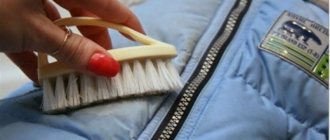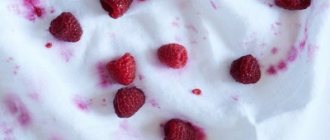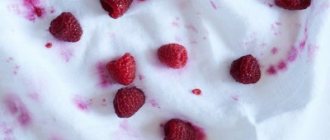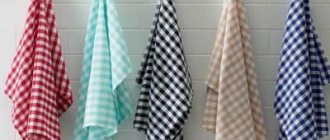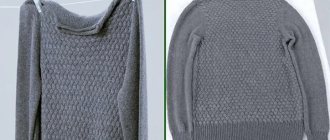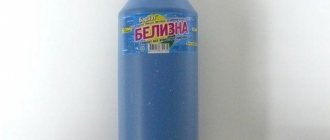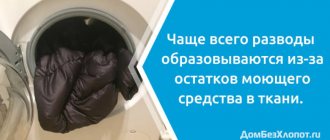Grease stains on outerwear almost always occur as a result of regular wear. Even if you treat things carefully and meticulously, oil or cosmetics may accidentally get on the fabric. You can actually remove these stains yourself using available products. As a rule, you always have at least one cleaning product at home.
Cleaning Rules
The main advice that housewives follow is: the sooner you start cleaning after the stain appears, the higher the chances of success. Basic rules to follow to remove grease stains from a down jacket:
- To prevent streaks, it is advisable to wash down jackets with liquid concentrates. Dry on hangers.
- If lumps of filler have formed, it must be disassembled manually. It is important to do this while the item is drying to prevent streaks from appearing on the surface of the item.
- You can use a stain remover suitable for your specific fabric type.
- After washing, you should rinse the down jacket 2-3 times.
- Peroxide cleanses the blood well. You need to moisten the stain with the liquid. The item can be washed after 20 minutes.
- Rub stains from household or cosmetic oils without pressing, so that the grease does not penetrate into the deep layers of the textile.
- A fresh stain should be blotted with a dry cloth, then treated with a detergent.
Mustard
Regular mustard will help get rid of dirt on dark or colored outerwear. Mix mustard powder with water to the consistency of thick sour cream, spread over the blot for 40 minutes. After the time has passed, wash the down jacket in a washing machine with powder.
Before cleaning, you need to test the method on the wrong side of the item.
Preparing for cleaning
An important step in cleaning a down jacket is preparation. Before removing contaminants, you need to:
- Mechanically remove dust and dirt.
- Try to determine how old the stain is.
- Prepare the necessary supplies and tools.
- Test the product to be used on a small area (preferably inside the jacket).
Advice! Before removing stains by any means, you need to study the information on the label.
How to eliminate white streaks after washing
Often, after washing, white stains remain on down jackets. Sometimes they can appear after snowfall or rain. The reason is insufficient rinsing. This situation occurs especially often after using washing powder. That's why outerwear manufacturers advise using liquid detergents for washing - they rinse out better and don't leave streaks. You can turn on the extra rinse mode.
- If white marks do appear, you can get rid of them using a damp cloth or viscose napkin, rinsing it regularly under running water.
- If the stains are very pronounced, you can first spray them with window cleaning liquid from a spray bottle and then wipe them off with a napkin.
- The most effective method to get rid of white stains is to wash the down jacket in the washing machine again, but without powder or detergent.
Folk remedies
As a rule, in the kitchen or pantry you can find everything you need for cleaning a down product at home. Salt, lemon, soap, dishwashing detergent, and other household products may come in handy. The product is selected based on the freshness and nature of the contamination.
Salt
Salt is used first. It copes well with new stains. Algorithm:
- Sprinkle the grains onto the stain.
- Wait 7-9 minutes. The fat must be absorbed. If this does not happen, add more salt.
- Wipe the surface with a dry cloth.
Soap
You can use toilet or laundry soap in a bar. Algorithm:
- Grate a piece on a fine grater.
- Combine with turpentine (take 1.5 times more than soap) and stir.
- Add one part of the total volume of ammonia.
- Apply the composition to the stain.
- After 30 min. rinse under the tap.
Mustard
Can be used on dark and colored fabrics. Algorithm:
- Mix the spice and water to a homogeneous paste (as thick as sour cream).
- Apply to the spot.
- After half an hour, wash according to the information on the label.
Shaving foam
A creative method using foam gives good results. Algorithm:
- Rub the product onto the mark.
- After 5 min. wash with liquid detergent.
Hydrogen peroxide and ammonia
A mixture of perhydrol with ammonia will help remove even old traces of fat. Algorithm:
- Mix peroxide with alcohol.
- Apply generously to the stained area.
- Wash after 1.5 hours.
Iron
A blotting paper can help clean grease-stained fabric. Algorithm:
- Place the paper on the spot.
- Iron with a warm iron: the fat should be absorbed into the paper.
Ammonia
Something as simple as ammonia can quickly help with household needs. Algorithm:
- Mix turpentine and ammonia (1:1).
- Use a cotton pad soaked in the solution to wipe the desired area.
- After 100-120 minutes. wash.
Lemon juice
Old fat from a down jacket can be easily removed with lemon juice. Algorithm:
- Cut the lemon in half.
- Squeeze onto stain.
- After 25 min. Rinse the area with water.
Advice!
You cannot replace juice with citric acid. The beads may scratch or tear the fabric.
Onion or lemon
To remove fat from bolognese fabric, use onion or lemon juice. Lemon juice for light-colored fabrics, onion for colored fabrics. Algorithm:
- Squeeze juice from lemon or onion.
- Apply to fabric using cotton wool.
- After 15-25 minutes. Wipe with a damp cloth until the stain is completely removed.
Vinegar
It is acceptable to use 9% table vinegar. Algorithm:
- Pour vinegar onto a cotton pad.
- Rub the mark several times.
- Rub the product with concentrated gel.
Dishwashing liquid
Dishwashing gel works well against new oil traces. Algorithm:
- Lather the product on a sponge.
- Wipe the fabric.
- After 4-9 minutes. wipe with a damp cloth.
- When completing the procedure, use a dry cloth.
Starch
To remove greasy stains on a down jacket, housewives often use potato starch. Algorithm:
- Sprinkle the powder onto the stain.
- Wait a few minutes for the fat to absorb a little. Repeat 2-3 times.
- Vacuum the dirty area to suck out any remaining starch.
Petrol
Men's down jackets often end up stained with machine oil. In this case, refined gasoline is effective. Algorithm:
- Wet a dry sponge.
- Apply a thin layer of gasoline.
- Wipe the desired area.
- After 5-10 minutes. Wipe with a damp cloth with a pleasant aroma.
- Air out your jacket.
Ammonia
Ammonia is characterized by degreasing properties and helps to cope with old stains. If the item is made of artificial fabric, then it is enough to apply alcohol directly to the blot. Wait 40 minutes, then wash the blot using powder. The product should be dried outside to get rid of the strong smell of ammonia.
If the down jacket is made from natural fabric and it is necessary to eliminate the oil trace, then you need 1 tbsp. Dilute ammonia in 70 ml of cold water and spread over the stain. If necessary, the procedure must be repeated.
You can remove greasy traces of gasoline by mixing equal amounts of ammonia and hydrogen peroxide. Distribute the prepared suspension over the area of contamination and leave for 20 minutes. After the time has passed, wash the item or remove any remaining residue with foam.
Solvents
Solvents should only be used if other methods have not helped. In this case, you need to wear household gloves. Before starting the procedure, the effect of the substance is checked on the inner part of the down jacket. Algorithm:
- Soak a cotton swab with a chemical solution.
- Wipe off the dirt, moving from the edge to the middle.
- After 0.5 hours, rinse the area with water.
Turpentine
Most often, housewives use a mixture of turpentine and ammonia. Algorithm:
- Combine turpentine and ammonia (proportion 1:1).
- Wipe the fabric with a cotton pad soaked in the solution.
- After 2 hours - wash.
Glycerol
A bottle of glycerin can be purchased at a pharmacy. Algorithm:
- Place a few drops on the desired area.
- After 30 min. wash off with a clean cloth.
Other special solvents
You can use any solvents you have at home. However, before use, be sure to test in an inconspicuous area. Aggressive liquids can damage textiles or change their color.
Methods for removing greasy stains from a down jacket
A down jacket is one of the things that does not like frequent washing - after just a few treatments it can lose its attractive appearance, become stained, wrinkle, etc. Therefore, housewives prefer to remove traces of fat from it locally, i.e. only in the area of the contamination. without subsequent washing. The option of dry cleaning an item will not be cheap, and if you consider that with constant wear the item quickly gets dirty, then such periodic cleanings will cost a lot of money.
The best option is to remove fresh greasy stains; they come off easily. But there are times when it is not possible to notice dirty marks on a jacket, and attention is paid to them after some time, when the fat has already eaten into the fabric and dried out. Even in such a severe case, there is salvation - some special stain removers prepared according to folk recipes can easily cope with such a problem.
If the method requires additional mechanical action (wiping the stain with the mixture, rather than applying it normally), it is important to follow one simple rule: move from the edges of the blot to the center. This will help avoid streaks and streaks. In addition, all residues of any product used must be removed after treatment.
After some means of cleaning the down jacket, subsequent washing becomes inevitable. Of course, you can try to remove the stains that appear after treatment by rinsing a large area of the area, but often this does not change anything.
We recommend reading: How to remove brilliant green from linoleum
How to remove old and stubborn stains
It is not always possible to remove stains from a down jacket immediately after they appear. There are methods proven by generations that can cope with old stains. Their effectiveness depends on the quality of the fabric, filler and the age of contamination.
The most effective option is the use of turpentine. It needs to be diluted with water and applied to cotton wool. Rub the stain vigorously for 8-10 minutes.
Advice! You need to start rubbing from the edges of the stain, moving towards its center.
Salt
If fat has just dripped onto the product, then generously sprinkle the area with salt. It will absorb fat, after which the item can be cleaned with a cotton pad or washed in a machine.
If the stain is old, then 1 tbsp. Mix salt with water to a porridge consistency, distribute over the problem area and leave for an hour. Remove dried product with a brush. Next, dilute 1 tsp. soda in 200 ml of water and wipe the stain.
Getting rid of shine on a jacket
On a down jacket, after a short period of wearing, a characteristic shine still appears on the cuffs and pockets. It is these areas that most often come into contact with our skin and other objects.
Pockets and sleeves are the most problematic areas; vinegar will help clean their shiny shine.
We get rid of shine using a vinegar solution:
- Take 3 parts water and 1 part vinegar.
- Wet the sponge in the resulting solution.
- We wipe our contaminated areas and then wash them.
To remove the smell of vinegar, take the item out into the fresh air to ventilate.
Preparatory measures
Simple, time-consuming steps will help improve your washing results:
- Remove the fur collar and belt with metal buckle (if these parts are present in a particular model). Large metal parts can oxidize and damage the machine drum.
- Remove all contents from your pockets - hardly anyone will be happy with a washed bill or flash drive, and small items that fall out can ruin the filter.
- If necessary, wash away heavy stains with laundry soap (usually on the cuffs, collar and hem).
- Fasten buttons, snaps, Velcro and zippers.
- Turn the jacket inside out to protect small parts from damage.
Common mistakes.
Practice shows that simple rules are often not followed when cleaning things, which gives disastrous results.
- cleaning with cheap washing powders;
- hot water;
- spin at high speeds;
- during drying, the trigger was hung inaccurately;
- the product is dried on the radiator;
- Do not pre-soak the item or use bleaches (stain removers).
All of the above actions lead to both the formation of lumps and damage to the item as a whole.
This happens due to the following reasons:
- Inexpensive powders dissolve very poorly in water and are not washed out of the filler, which ensures its adhesion.
- High water temperatures are unfavorable for natural fillers; as a rule, they lose their thermal insulation properties.
- High drum speeds lead to the fact that the fluff clumps into one large lump.
- If the down jacket is laid out or not hung carefully, it dries unevenly and becomes wrinkled. Afterwards you will have to use an iron to smooth out the folds.
- If the item is dried on a direct heat source, the process will be uneven. If there is a chance that some areas inside will remain damp, which may cause an unpleasant odor.
- Fillers are very sensitive to various types of chemicals, so the use of strong agents (all stain removers are classified as such) will ruin the fluff.
